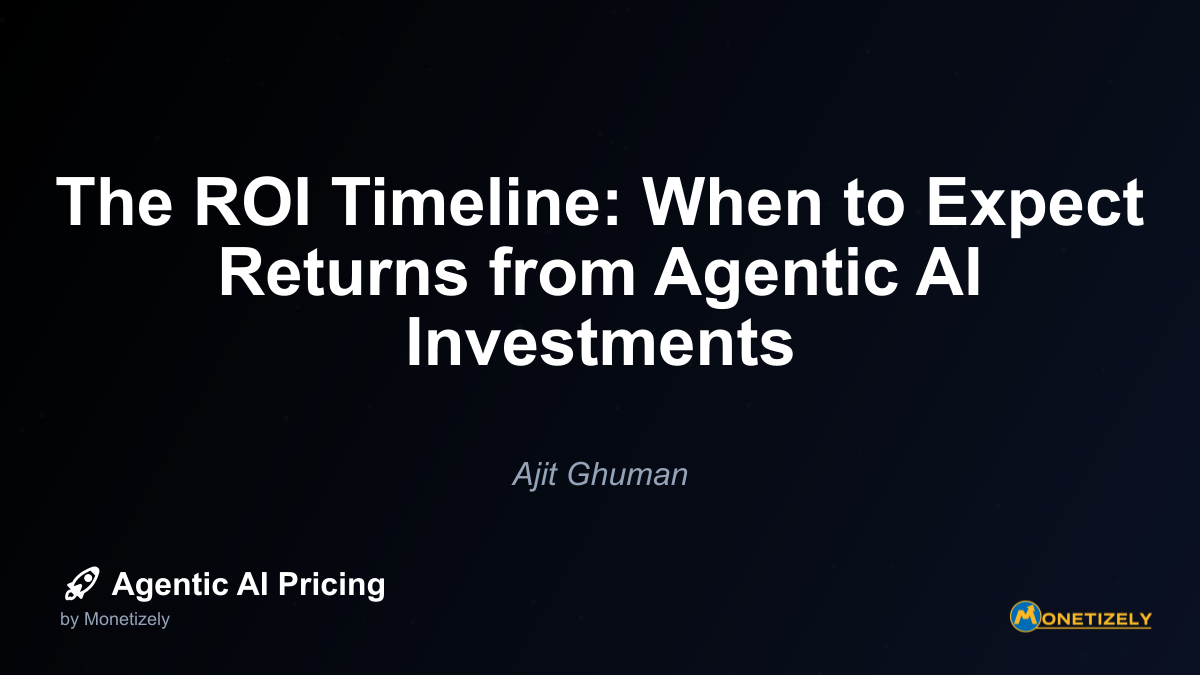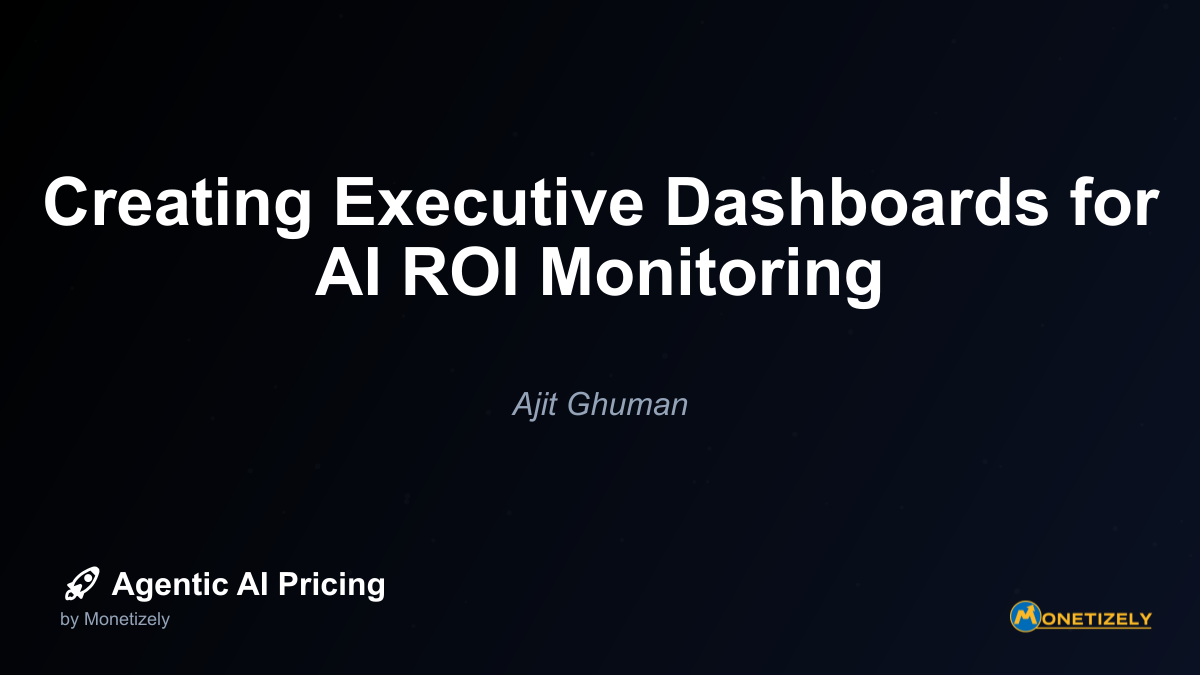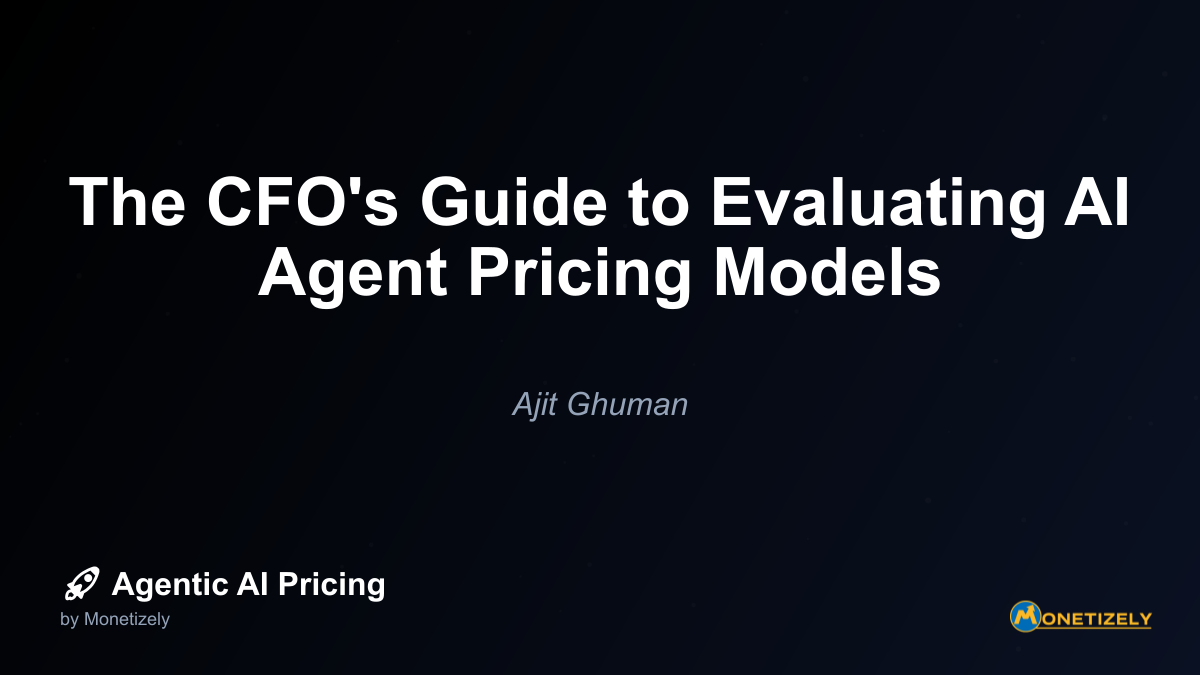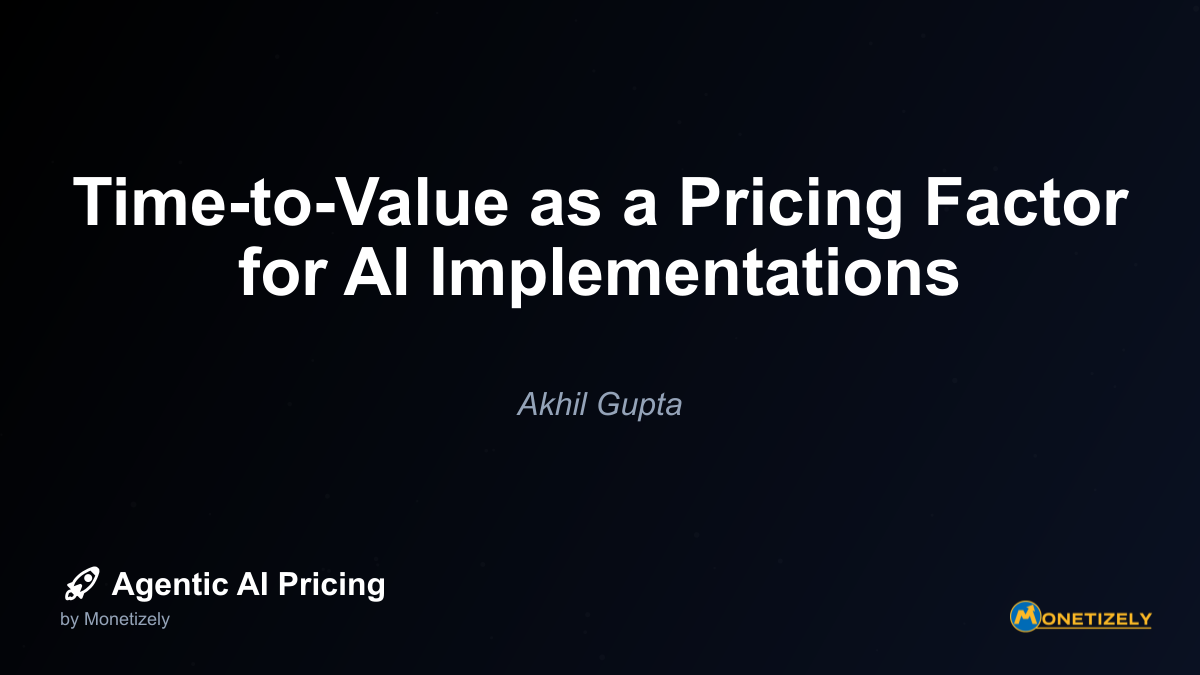· Akhil Gupta · ROI & Value · 11 min read
AI Agent Pricing for Business Process Outsourcing Replacement
AI and SaaS Pricing Masterclass
Learn the art of strategic pricing directly from industry experts. Our comprehensive course provides frameworks and methodologies for optimizing your pricing strategy in the evolving AI landscape. Earn a professional certification that can be imported directly to your LinkedIn profile.
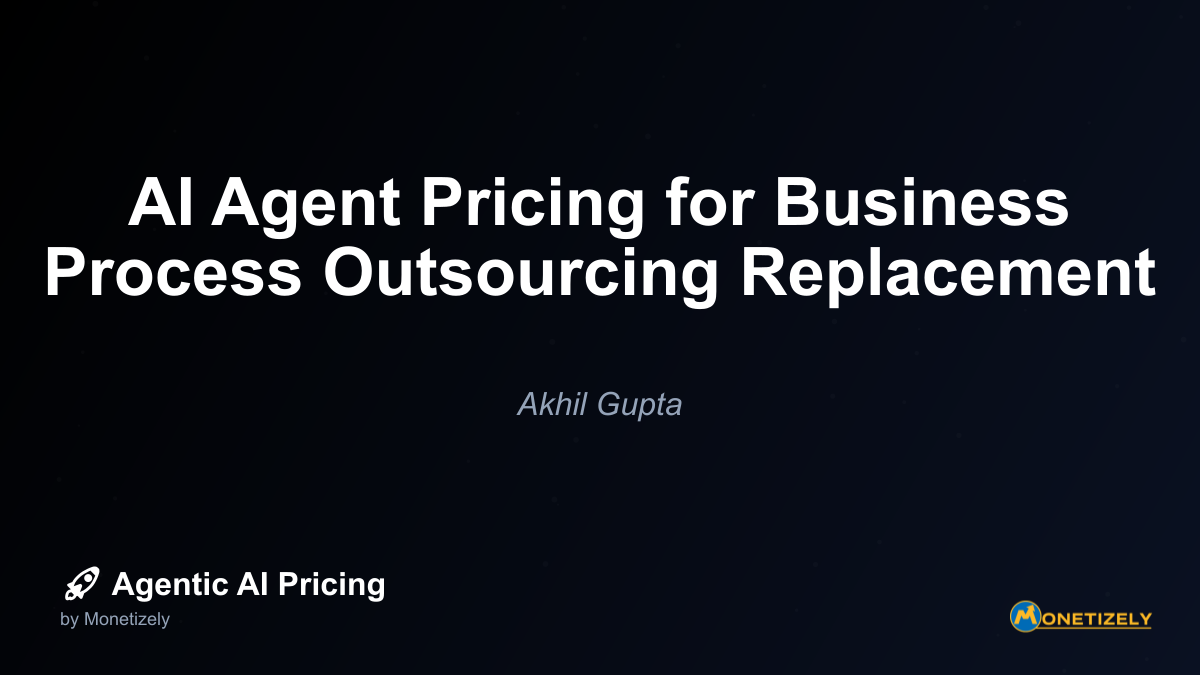
The business process outsourcing (BPO) industry is experiencing a profound transformation as AI agents increasingly replace traditional human-operated services. This shift presents both tremendous opportunities and complex challenges for organizations navigating the transition. Understanding how to effectively price AI solutions that replace BPO services requires a comprehensive analysis of cost structures, value creation, and return on investment frameworks.
The Evolving BPO Landscape: From Human Labor to AI Agents
The global BPO market, valued at approximately $388 billion in 2024, is projected to reach nearly $680 billion by 2033, growing at a CAGR of 6.42%. However, this growth masks a fundamental transformation occurring within the industry. Traditional BPO services built on labor arbitrage and human-operated processes are rapidly giving way to AI-powered alternatives that promise greater efficiency, accuracy, and scalability.
This evolution is driven by compelling performance metrics:
- AI-powered support agents manage approximately 13.8% more customer inquiries per hour
- Automation of 60-70% of employees’ time-consuming tasks
- Operational cost reductions averaging 57%
- 31.5% improvement in customer satisfaction
- 24.8% rise in customer retention
- 20-25% increase in first-call resolution rates
- 80-90% reductions in error rates
These metrics highlight why organizations across financial services, healthcare, customer support, and manufacturing are increasingly replacing traditional BPO arrangements with AI-powered alternatives. However, this transition requires a fundamental rethinking of pricing models, value assessment, and ROI calculation.
Dominant AI Agent Pricing Models for BPO Replacement
The pricing landscape for AI agents replacing BPO services has evolved to include several distinct models, each with specific advantages, challenges, and suitability for different use cases.
1. Per-Agent (FTE Replacement) Pricing
This model positions AI agents as digital employees, charging a fixed monthly fee per AI agent that replaces a human full-time equivalent (FTE).
Key characteristics:
- Fixed monthly fee per AI agent (typically a fraction of human FTE cost)
- Positioned as a headcount replacement rather than software/IT expense
- Facilitates easier budgeting from existing headcount allocations
- Well-suited for comprehensive task substitution
Real-world examples:
- Companies like 11x, Harvey, and Vivun charge approximately $2,000/month per AI agent, positioned as replacing junior employees who would cost $60,000/year plus benefits
- Pricing typically ranges from 30-50% of the fully-loaded cost of the human role being replaced
ROI calculation approach:
- Direct comparison of AI agent monthly cost vs. equivalent human salary + benefits
- Measurement of reduction in full-time hires or contractor expenses
- Evaluation of productivity multiplier (how many human tasks one AI agent can handle)
2. Usage-Based/Token-Based Pricing
This model charges based on units of AI resource consumption, such as API calls, tokens processed, or transactions handled.
Key characteristics:
- Variable costs based on actual usage volume
- Highly flexible for fluctuating workloads
- Less predictable for budgeting purposes
- Well-suited for pilot programs or variable usage scenarios
Real-world examples:
- Many generative AI platforms charge per token processed ($0.01-$0.10 per 1,000 tokens)
- Transaction-based pricing for document processing ($0.05-$0.25 per document)
- API call pricing for customer service interactions ($0.01-$0.10 per interaction)
ROI calculation approach:
- Cost per transaction comparison (AI vs. human-operated BPO)
- Volume-adjusted cost analysis accounting for peaks and valleys
- Efficiency gains measured by cost per customer interaction
3. Outcome-Based/Performance-Based Pricing
This increasingly popular model ties pricing directly to business outcomes achieved by the AI agent.
Key characteristics:
- Payment linked to specific measurable outcomes
- Strong alignment between cost and value creation
- Requires robust tracking and measurement systems
- Complex to implement but potentially most fair to both parties
Real-world examples:
- Sales AI agents priced per qualified lead generated
- Customer service AI priced per resolved ticket
- Collection agents priced as percentage of recovered revenue
- Document processing AI priced per successful extraction with defined accuracy levels
ROI calculation approach:
- Direct measurement of incremental revenue or cost savings
- Comparison of outcome quality and volume against baseline
- Attribution analysis to isolate AI contribution to outcomes
4. Flat-Rate/Subscription Pricing
This traditional SaaS model provides unlimited or capped access to AI agent functionality for a fixed recurring fee.
Key characteristics:
- Predictable costs for budgeting purposes
- Simplifies procurement and accounting
- May lead to inefficiencies if usage varies significantly
- Often includes tiered pricing based on feature sets or capacity limits
Real-world examples:
- Basic customer service AI packages starting at $5,000/month
- Enterprise-grade document processing solutions at $25,000-$50,000/month
- Specialized industry solutions (healthcare claims, financial compliance) at $15,000-$100,000/month
ROI calculation approach:
- Period-based comparison of subscription cost vs. previous BPO expenses
- Utilization analysis to ensure efficient use of subscription capacity
- Feature value mapping to quantify benefits of included capabilities
5. Hybrid Pricing Models
Many vendors combine elements of multiple pricing models to balance predictability, fairness, and alignment with value.
Key characteristics:
- Base subscription plus usage components
- Outcome guarantees with usage-based pricing
- Per-agent pricing with volume discounts
- Flexible combinations tailored to specific use cases
Real-world examples:
- Salesforce and HubSpot combine per-seat user licenses with additional per-agent fees
- ServiceNow includes AI agents at higher tiers of their seat pricing plans
- Customer service platforms offering base subscription with additional per-resolution fees
- Document processing solutions with base platform fee plus per-document charges
ROI calculation approach:
- Component-based analysis separating fixed and variable costs
- Multi-factor efficiency measurement across usage, outcomes, and headcount
- Comparative analysis against traditional BPO cost structures
Comprehensive ROI Frameworks for AI-BPO Replacement
Calculating the return on investment for AI agents replacing BPO services requires a comprehensive framework that accounts for both direct cost displacement and broader value creation. Organizations typically see ROI ranging from 200-300% over a 24-month period, driven by multiple value components.
1. Direct Cost Displacement Framework
This framework focuses on the immediate labor and operational costs eliminated by implementing AI agents:
Labor Cost Displacement:
- Fully-loaded employee costs (salary, benefits, facilities, management overhead)
- Contractor and temporary staff expenses
- Overtime and peak staffing costs
- Training and onboarding expenses
- Employee turnover and recruitment costs
Operational Cost Displacement:
- Reduced error correction and rework expenses
- Lower quality assurance and monitoring costs
- Decreased compliance and regulatory violation costs
- Eliminated geographic constraints and associated expenses
- Reduced technology infrastructure for human workers
Calculation Methodology:
- Establish baseline per-transaction or per-employee costs for current BPO operations
- Calculate fully-loaded costs including direct and indirect expenses
- Compare with AI agent implementation and operating costs
- Factor in transition costs and timeline to determine breakeven point
2. Efficiency Gains Framework
This framework quantifies the productivity improvements and operational efficiencies gained through AI implementation:
Volume and Throughput Improvements:
- Increased transactions processed per hour/day
- Reduced average handling time per case
- Elimination of backlogs and processing delays
- 24/7 operational capability without shift premiums
- Instant scalability for demand fluctuations
Quality and Accuracy Enhancements:
- Reduced error rates and associated rework
- Improved compliance with regulatory requirements
- Consistent application of policies and procedures
- Elimination of human variability and bias
- Higher first-contact resolution rates
Calculation Methodology:
- Measure baseline performance metrics for key processes
- Quantify improvements in throughput, accuracy, and consistency
- Assign financial value to efficiency gains based on cost avoidance or revenue impact
- Factor in continuous improvement capabilities of AI systems
3. Strategic Value Creation Framework
This framework addresses broader business value created beyond direct cost savings:
Customer Experience Improvements:
- Increased customer satisfaction scores
- Higher net promoter scores and loyalty metrics
- Reduced customer effort scores
- Lower customer churn and higher retention
- Increased customer lifetime value
Business Intelligence and Insights:
- Data-driven decision making from AI analytics
- Predictive insights for proactive business actions
- Process optimization through pattern recognition
- Competitive advantage through superior operations
- Strategic resource reallocation to higher-value activities
Calculation Methodology:
- Establish baseline customer metrics and business performance indicators
- Measure changes following AI implementation
- Quantify financial impact of improved customer retention and satisfaction
- Assess value of insights and predictive capabilities
- Calculate long-term strategic value creation
4. Total Cost of Ownership Framework
This framework provides a comprehensive view of all costs associated with both traditional BPO and AI alternatives:
Traditional BPO TCO Components:
- Direct service fees and contractual costs
- Management and oversight expenses
- Quality assurance and compliance monitoring
- Integration and technology compatibility costs
- Contract management and vendor relationship expenses
- Hidden costs of geographic and time zone challenges
AI Agent TCO Components:
- Implementation and integration expenses
- Ongoing subscription or usage fees
- Training and adaptation costs
- Maintenance and continuous improvement expenses
- Human oversight and exception handling
- Technology infrastructure requirements
Calculation Methodology:
- Document all direct and indirect costs for current BPO operations
- Project comprehensive costs for AI implementation and operation
- Develop multi-year TCO comparison with sensitivity analysis
- Factor in risk adjustments for both approaches
Real-World Implementation Case Studies
Examining how organizations have successfully implemented and priced AI agents to replace BPO services provides valuable insights into practical applications of these frameworks.
Financial Services: Auto Lending Process Transformation
Challenge: A major auto lender relied on offshore BPO services for invoice reconciliation, claims management, and cost allocation, resulting in high error rates and processing delays.
Solution: Implemented AI agents from Salient to automate repetitive back-office tasks, replacing manual BPO operations.
Pricing Model: Hybrid approach combining per-agent monthly fee with performance incentives tied to accuracy rates.
Results:
- 57% reduction in operational costs
- 80% decrease in processing errors
- 40% faster processing times
- 200% ROI achieved within 18 months
- Redeployment of 30% of staff to higher-value activities
Key Insight: The hybrid pricing model aligned vendor incentives with quality outcomes while providing predictable base costs, creating a win-win scenario for both parties.
Healthcare: Revenue Cycle Management Optimization
Challenge: A healthcare network struggled with high denial rates and slow billing processes using traditional BPO services for claims processing.
Solution: Deployed Camber’s generative AI platform to automate revenue cycle management functions previously handled by BPO providers.
Pricing Model: Outcome-based pricing tied to successful claim approvals and reduction in denial rates.
Results:
- 80% reduction in claim denials on first submission
- 50% faster billing processes
- No increase in overall costs
- Improved cash flow and reduced days in accounts receivable
- Enhanced compliance with evolving healthcare regulations
Key Insight: The outcome-based pricing model created perfect alignment between the AI provider’s compensation and the healthcare organization’s financial goals, while eliminating the need for complex usage tracking.
Chemical Industry: Customer Support Transformation
Challenge: A leading chemical company relied on traditional BPO services for email categorization, spam detection, and routing, resulting in slow response times and inconsistent handling.
Solution: Implemented Beam AI’s agents to automate 97% of email processing workflows.
Pricing Model: Usage-based pricing with volume tiers and minimum commitments.
Results:
- 63% reduction in outsourcing costs
- 56% faster response times
- Significant productivity gains
- Extension of AI capabilities to sales enablement
- Implementation of real-time live AI call support agents
Key Insight: The usage-based pricing model with volume tiers allowed the organization to start small and scale as confidence in the AI solution grew, while providing predictability through minimum commitments.
Transportation & Logistics: Freight Auditing Revolution
Challenge: A transportation company used traditional BPO services for freight invoice auditing, a labor-intensive process prone to errors and missed recovery opportunities.
Solution: Implemented AI solutions from Loop to automate invoice reconciliation and claims processing.
Pricing Model: Performance-based pricing as a percentage of identified savings and recovered claims.
Results:
- 35% increase in identified billing discrepancies
- 42% reduction in processing costs
- Improved accuracy and reduced fraud risk
- Enhanced data visibility and reporting
- Seamless scaling during peak shipping seasons
Key Insight: The performance-based pricing created a true partnership where the AI provider’s success was directly tied to the value delivered, eliminating the need for the client to calculate complex ROI metrics.
Strategic Implementation and Pricing Considerations
Successfully implementing AI agents to replace BPO services requires careful planning and strategic decision-making around pricing models and transition approaches.
1. Phased Implementation Strategy
Rather than attempting a wholesale replacement of BPO services, organizations should consider a phased approach:
Phase 1: Pilot and Proof of Concept
- Select specific, well-defined processes for initial implementation
- Establish clear baseline metrics for comparison
- Implement AI alongside existing BPO operations
- Gather data on performance, accuracy, and cost implications
- Refine implementation approach based on pilot results
Phase 2: Scaled Deployment
- Expand to additional processes and functions
- Begin phased reduction of traditional BPO services
- Implement refined pricing models based on pilot learnings
- Develop comprehensive transition plan for affected staff
- Establish governance framework for AI operations
Phase 3: Enterprise Integration
- Fully integrate AI agents into core business operations
- Implement advanced capabilities and cross-functional workflows
- Optimize pricing models based on actual usage and outcomes
- Develop centers of excellence for AI governance
- Continuously evolve capabilities through machine learning
This phased approach allows organizations to validate ROI assumptions, refine pricing models, and manage change effectively while minimizing disruption.
2. Pricing Model Selection Framework
Selecting the optimal pricing model requires careful consideration of multiple factors:
Business Model Alignment:
- How does the pricing model align with your organization’s budgeting processes?
- Is the cost categorized as headcount, technology, or operational expense?
- Does the model provide predictability for financial planning?
- How does it compare to current BPO contract structures?
Risk Allocation:
- Which party bears the risk of underperformance or lower usage?
- How is quality and accuracy incentivized in the pricing model?
- Are there guarantees or service level agreements included?
- What remediation processes exist for issues or failures?
Value Capture Mechanism:
- How does the pricing model capture and share created value?
- Is there alignment between vendor compensation and business outcomes?
- Does the model scale appropriately with success?
- Are there caps or collars on pricing to prevent unexpected costs?
Implementation Considerations:
- Does the pricing model support phased implementation?
- Are there incentives for successful knowledge transfer?
- How does pricing handle the transition period?
- What flexibility exists to adjust as requirements evolve?
Organizations should develop a scoring matrix that evaluates potential pricing models against these criteria, weighted according to their specific priorities and constraints.
3. Technical Integration Requirements
Successful implementation of AI agents requires careful attention to technical integration requirements:
Data Access and Quality:
- Ensure AI agents can access required data sources
- Establish data cleansing and preparation processes
- Define data governance and security protocols
- Address any legacy system integration challenges
Workflow Integration:
- Map existing BPO processes in detail
- Identify integration points with current systems
- Design exception handling and escalation procedures
- Establish monitoring and oversight mechanisms
Technology Infrastructure:
- Assess cloud vs. on-premises requirements
- Determine computing and storage requirements
- Establish security and compliance frameworks
- Implement redundancy and disaster recovery protocols
Performance Monitoring:
- Develop comprehensive KPI dashboards
- Implement real-time monitoring capabilities
- Establish quality assurance processes
- Create continuous improvement feedback loops
The technical integration requirements directly impact implementation costs and timeline, which must be factored into ROI calculations and pricing negotiations.
Ethical and Regulatory Considerations
Replacing human BPO workers with AI agents raises important ethical and regulatory considerations that must be addressed as part of any implementation strategy.
1. Workforce Transition and Reskilling
Organizations have an ethical responsibility to manage the transition for affected workers:
Reskilling Initiatives:
- Develop comprehensive training programs for new roles
- Focus on skills that complement AI capabilities (empathy, complex problem-solving, creativity)
- Create career paths for workers to move into AI supervision and governance
- Partner with educational institutions for technical skill development
Transition Support:
- Provide advance notice and clear communication
- Offer outplacement services and career counseling
- Consider phased transitions to allow adjustment time
- Implement retention incentives for critical knowledge transfer
New Role Development:
- Create positions focused on AI oversight and exception handling
- Develop specialized roles for complex cases beyond AI capabilities
- Establish AI training and improvement teams
- Design customer experience enhancement roles leveraging human empathy
The costs of these workforce transition initiatives must be factored into
Co-Founder & COO
Akhil is an Engineering leader with over 16+ years of experience in building, managing and scaling web-scale, high throughput enterprise applications and teams. He has worked with and led technology teams at FabAlley, BuildSupply and Healthians. He is a graduate from Delhi College of Engineering and UC Berkeley certified CTO.
Pricing Strategy Audit
Let our experts analyze your current pricing strategy and identify opportunities for improvement. Our data-driven assessment will help you unlock untapped revenue potential and optimize your AI pricing approach.

